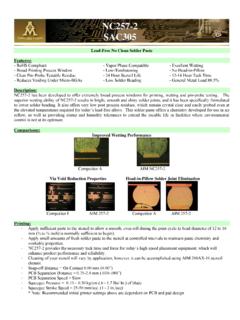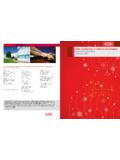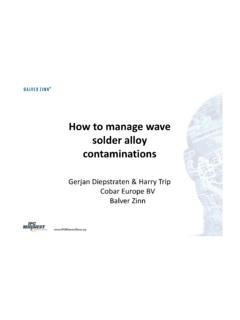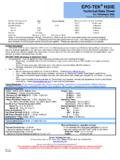Transcription of 100% Pure Tin Plating Process - Natronix
1 7 Tin Plating Sep 2, 2013 Page 1 of 4 100% pure Tin Plating Process Need for the Process : The demand from the semiconductor industry for Green-IC packaging is gaining momentum. In Japan the Japanese Electronic Industry Association (JEIDA), has been formed to monitor its Green progress, and in Europe the European Waste in Electrical and Electronic Equipment (WEEE) taskforce is directed to minimize the environmental impact of electronic waste.
2 Although the US has no pending legislation to ban lead, there has been legislation introduced to encourage recycling of electronic products. As the world turns to Green manufacturing, the next generation of IC assembly service providers must have this option in their portfolio in order to comply with industry legislation and demand. A product is lead-free if it has less than lead by weight, and where none has been intentionally added as part of the manufacturing Process . SPEL in order to nurture the nature and to meet the European Commission directives that will be in force by July 1st 2006 has qualified the 100% Tin Plating Process in a dedicated Plating line which will replace lead from all its products.
3 Why did SPEL choose 100% pure Tin: Since the 100% pure tin Process is increasingly becoming the most popular and cost effective viable lead-free alternate and is most demanded by Customers, SPEL preferred to choose 100% matte tin Process . Also the Process was relatively simpler to switch over without any major capital investment (other than a brand new automatic Plating line) and technical concerns. There is plenty of Plating chemical suppliers for this Process worldwide and this is almost the final choice of lead-free Plating finish in the semiconductor industry.
4 The evaluation results are very promising and the other alloy combinations are not fully understood / developed in the industry. SPEL has done extensive testing on a variety of package types, under a variety of stress conditions and there is no abnormal case reported with whisker growth. SPEL adopts the post plate annealing technique (150 C, 1 hour duration bake) to mitigate the whisker growth. 100% pure tin chemistry chosen by SPEL has proven to be stable and resistant to whisker growth. Also SPEL has included the whisker growth study in its regular reliability monitoring plan under various conditions of stress for effective monitoring and control.
5 pure Tin Plating technique is relatively simple Process to control for those who are already involved in Tin-Lead Plating Process . pure tin has excellent solderability and is compatible with lead-containing solder pastes. The higher melting point of tin (232 C) allows it to be used for high temperature applications. The metal has a relatively lower costs and the availability is not a concern. Tin has got good solderability and wetting properties. Also it is easy to deposit and no issues prevail on the composition. However this Process is not free from risk factors such as whiskers.
6 Whiskers from Tin plated units are highly dependant on the Plating chemistry adopted and mitigations strategies recommended by the chemical suppliers to alleviate the concerns related to whiskers making the Process to gain worldwide acceptance. Of the available pure tin Process chemistries in the market SPEL preferred the particular chemistry because it provides a uniform grain structure with a grain size of 3 to 8 Microns. Besides this the Process is environment friendly, fluoride free and the deposit gives excellent solderability even after heat ageing at 155 C for 16 hours.
7 Also the supplier s pre-cleaning chemicals are already in use in SPEL and are compatible with the pure tin Process . 7 Tin Plating Sep 2, 2013 Page 2 of 4 About Whiskers: The growth mechanism takes by the diffusion of copper from the base material in to the tin deposit over time causing the formation of intermetallics that causes stresses on the remaining pure tin grains.
8 In this Process to relieve the internal stresses, whiskers are formed. Whisker growth mechanism Mitigation strategies The driving force for whisker formation is the internal compressive stress, crystal grain structure of the finish, Plating chemistry and the Plating Process parameters. Following are the factors which can induce compressive stress in the plated deposit. Diffusion of Irregular intermetallics Surface oxide Deposit grain size, shape and orientation Substrate Plating current density Low Plating thickness ( < than 8 Micron) Impurities in the deposits such as carbon and hydrogen Excessive mechanical bending and scratches Thermal cycling Following are the universally accepted mitigation strategies which will relieve the compressive stresses in the plated deposit.
9 Post plate anneal at 150 C for 1 hour ( within 24hours of Plating ) Nickel under layer Plating Of the above choices SPEL adopts the post plate anneal immediately after Plating to relieve the stress. Also SPEL has done extensive reliability stress test in the pure tin plated products to study the whisker growth. Mild whisker growth to the maximum length of mils was observed in the temperature cycled devices alone which is well below the NEMI accepted limit of 3 mils for the particular type of package. 7 Tin Plating Sep 2, 2013 Page 3 of 4 Alternative lead-free lead finish materials Alternative "lead-free" lead finish materials for use in the solder Plating shall have a stringent visual, mechanical, electrical, and chemical requirements similar to that of Tin/Lead.
10 These requirements include acceptable melting point, good wettability / solderability, high adhesion/mechanical strength, excellent conductivity and compatibility with the Lead free and Tin/ Lead solder pastes. The solder must also allow high volume production, inspection, and if necessary, rework, while remaining to be reliable and cheap. Some possible options and their pros and cons are described below. Tin Zinc: Sn 9%Zn has a melting temperature of 198 C, making it a close alternative to eutectic Sn-Pb solder . Once solidified, it exhibits large grains with a fine and uniform two-phase eutectic colony.







